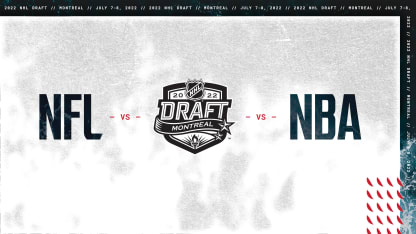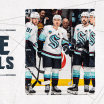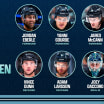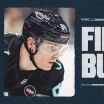Draft weekend is a heady time for any pro sports franchise. It's a time when months and months of work culminate in the organization selecting their players of the future. Players projected to help obtain the ultimate goal: a Stanley Cup championship.
But unlike sports leagues such as the NBA and NFL, in the National Hockey League, the path from draft day to pro-level play can be a little different.
Both the NHL and the NFL have 32 teams. Both sports' drafts traditionally allow for the selection of 224 players across seven rounds (that number can increase for both the NFL and NHL due to compensatory picks).
The Power of Patience
Compared to other pro sports, especially the NFL and NBA, the success rate of drafting potential NHL players requires a longer development timeline and ability to gauge long-term potential

But while each draft usually allows for the same number of draftable spots, that's where similarities end. In the NFL, according to pro-football-reference.com, 239 players of the 259 selected in the summer of 2021 have already played at least one pro game and 157 have played 10 or more.
Meanwhile, to date, just six hockey players drafted in 2021 have played in an NHL game with only two (Matty Beniers is one), having played 10 games or more. Even if we go back through the last decade of Draft selections (2012-21), per hockey-reference.com, there has yet to be a draft class to yield 100 or more NHL players (playing one or more NHL games).
So, what gives? Why this disparity? Even in the NBA, per Basketball-Reference.com, 53 of 60 drafted players in 2021 hit the court for their NBA team at least once, and 32 played at least half the season. We don't see as many NHL draft picks making an immediate leap to the pros.
The reality is not all pro drafts are created the same. And as the Kraken prepare to bolster their prospect pool with up to 12 selections in July's entry Draft, their journey to the NHL playoffs may be different than what we see in other sports.
Let's dig in.
It's a Numbers Game
First, we have to understand the sheer number of players being brought into the mix and the size of a league's prospect pool. NHL and NFL drafts allow for approximately the same number of players to be selected every year (224). The NBA is obviously significantly lower with just two rounds of picks across all 30 teams (60); while baseball (MLB) casts the widest net of all with 20 rounds of selections for each of the 30 teams (600!).
If we look at available roster spots each year, the NHL (736 roster spots) is second lowest only to the NBA (510 roster spots, including two-way players) in terms of the number of players who are in the big leagues at any given time. In comparison, MLB offers 840 roster spots every season and the NFL has a whopping 1,696 opportunities to play.
There's no right or wrong here, but in the NHL, it's important to understand there are going to be fewer openings for a player to climb to the big club straight out of being drafted.
Specialty and Opportunity
But don't fall prey to the idea of "well, if there were more roster spots there would be more drafted players in Year 1..." Another reason more players find their way to the NFL field is the variety of roles a player can fill in football. Some players might only see action on special teams. Some players only kick field goals or punt. The demand for "specialists" and a wide variance in playing time tied to any given role mean players with one specific skill, or a narrower set of skills, can make NFL rosters.
The beauty of hockey is the demand of the "five-man unit." Each skater is being asked at times to play offensively and at times to play defensively. The only true specialist in hockey is the goaltender. To step into an NHL game, you need to possess a variety of skills, even if one area of the game might be your focus. Developing a well-rounded game can take more time than being able to slot in and do just one thing. Speaking of which…
All in Good Time
When the NBA, NFL or MLB draft a player, the team gains control of a player's rights and where the athlete plays. Even if that player isn't instantly slotted at the highest level of the sport, an organization can directly oversee how that player works on skills, how they train and more.
A vast majority of drafted players in football and basketball have comparable development paths before going pro, predominantly at the NCAA level from the ages 18 to 23 depending on the individual's progress. They tend to be much closer to fully-formed potential as pro performers. Think college basketball or football…where often, the greatest variance is what conference you played in.
Hockey is different. Players are being drafted during their 18-year-old birth year (in some cases, 19 or 20). That's an age in which evaluating potential is just as important as evaluating current level of skills. Scouts, GMs, analytics experts and other front office personnel are all looking intently into the future when attending prospects' games or watching video in the present.
Even after being drafted, there are countless paths for players to develop. A drafted player might play in the NCAA or go the elite juniors route in the Canadian Hockey League (CHL) or the United States Hockey League (USHL). And there are countless other major junior programs and pro teams (the most elite juniors moving up to the parent club similar to soccer) playing throughout Europe and Russia that can be stocked with draft-eligible players.
There's also the American Hockey League, where more than 90 percent of all NHLers have honed their skills and mindsets prior to joining an NHL team. In those scenarios, of course, organizations like the Kraken invest in each prospect and collaborate with a player's team to ensure the player is growing in the right ways that are best for them.
Ultimately, on a player-to-player basis, the steps she or he takes to be "NHL-ready" can be different and come at different times. Plus, the demands of position and role for each player factor as well. Over the last ten years, the average age of an NHL goaltender debuting was 24.2 years according to Hockey Reference. In comparison, the average forward was 21.8 years old, and the average defender was 22.1 years of age when making NHL debuts.
This is just part of why we often hear the phrase about drafting "the best player available." Projecting when a player will be ready and what a team's roster will look like at that exact time is a nearly impossible thing to forecast.
Going Deep
Of course, draft position can play a part in a player's readiness and development too. If we look at all players drafted in the last 10 NHL Entry Drafts, 84.3-percent of all players selected in the first round have played at least one NHL game. The amount drops to 51.1-percent for second-rounders; 37.6-percent for third-round picks; and less than 30-percent of players chosen in each of rounds 4 to 7 to date have seen NHL ice with the lowest (13.3%) coming in the seventh round.
We see a similar relationship to draft position in all sports
including the NBA
and
NFL
.
This is what makes the work of scouting and all types of prospect analysis so valuable. Having the ability to leave no rock unturned or, more directly, no player undiscovered, is what helps find the most value at every possible draft position.
The Takeaway
In other professional sports, we often see this year's draft pick turn into next year's star or valuable reserve. That's not unheard of in hockey, but it's less the norm. Being drafted at a younger age, along with variance in where and how a player develops, means that time frames for getting to the NHL aren't as normalized as in the NFL or NBA. The NHL draft success rates lean heavily on strength in an organization's ability to evaluate potential along with focused patience, to lay the groundwork for winning that coveted Cup.
Data via Hockey-Reference.com; Pro-Football-Reference.com; Basketball-Reference.com


















